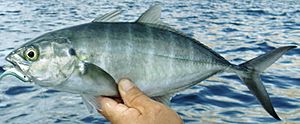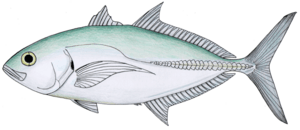Green jack facts for kids
Quick facts for kids Green jack |
|
|---|---|
 |
|
| Conservation status | |
| Scientific classification | |
 |
|
| Approximate range of the green jack | |
| Synonyms | |
|
The green jack (Caranx caballus), also known as the horse jack, is a common fish found in the ocean near coastlines. It belongs to the jack family called Carangidae. You can find this fish in the eastern Pacific Ocean, along the coast of the Americas. Its home stretches from Santa Cruz Island in California all the way down to Peru. It also lives around islands like the Galápagos Islands and, more recently, Hawaii.
Green jacks are special because of certain features. These include how many gill rakers they have and the scales on their lateral line. They also have a special fatty eyelid. This fish can grow to at least 55 cm long and weigh about 2.81 kg. Some people say they can grow even bigger! Green jacks live in many different places on the continental shelf. This includes estuaries, bays, reefs, and deep-sea seamounts. They can live both near the bottom (demersal) and in the open water (pelagic).
The green jack is a predator. It hunts and eats other fish, crustaceans (like crabs and shrimp), and cephalopods (like squid). They also eat tiny zooplankton. Most green jacks are ready to reproduce when they are about 38 cm long. They usually lay their eggs between May and October. This fish is very important for fisheries in the areas where it lives. People catch them using large trawl nets, other types of netting, and hook and line. Anglers also enjoy catching green jacks with bait and lures. However, many people think they are only fair to eat.
Contents
Green Jack Fish
What is a Green Jack?
The green jack is a type of fish that belongs to a group called "jacks and trevallies." Its scientific name is Caranx caballus. This group of fish is part of the Carangidae family. The Carangidae family is in the larger group known as the order Carangiformes.
How it Got its Name
The green jack was first described by a French biologist named Charles Frédéric Girard in 1858. He first called it Trachurus boops. This name put it in the same group as horse mackerel. The first fish he studied came from San Diego, California.
Over time, scientists changed how they classified these fish. In 1868, a British zoologist named Albert Günther gave the fish a new name, Caranx caballus. He did not know that Girard had already named it. Günther studied fish from Panama. Later, another scientist tried to rename it again. But because Günther's name was given earlier, Caranx caballus became the official scientific name. The word caballus is Latin for 'horse'. This is why it is also called the "horse jack." The common name "green jack" comes from its greenish-blue color. In Spanish-speaking countries, it is often called cocinero or caballa.
How it Looks
The green jack is a medium-sized fish. It can grow up to 55 cm long and weigh about 2.81 kg. Some people have reported seeing them as long as 1 meter, but most are less than 40 cm. This fish looks similar to other jacks. It has a long, somewhat flat body that is shaped like a torpedo. Its top and bottom parts are equally rounded, and its snout is a bit pointy.
The back of its eye has a well-developed fatty eyelid. Its jaw ends right below the center of its eye. The fish has two dorsal fins on its back. The first has 8 stiff spines. The second has 1 spine and 22 to 25 soft rays. The anal fin on its underside has 2 separate spines at the front, followed by 1 spine and 16 to 21 soft rays. The tips of both the second dorsal and anal fins are a bit long and covered in small scales.
The lateral line on its side has a short curve at the front. The straight part of the lateral line has 42 to 56 strong scales called scutes. The fish's chest is fully covered in scales. Its upper jaw has a row of outer canine teeth and an inner band of smaller teeth. The lower jaw has a single band of small teeth. Green jacks have 40 to 45 gill rakers. They also have 25 vertebrae (backbones).
When alive, the green jack is greenish-blue. Its back is olive green to dark blue, and its belly is golden to gray. It has a clear black spot on the outer edge of its gill cover. Fish in schools often have a shiny white mark near this black spot. Young green jacks have 7 dark stripes on their sides, which fade as they get older. Their caudal fin (tail fin) is gray with dark tips. All other fins are light gray or clear.
Where Do Green Jacks Live?
The green jack lives in the coastal waters of the tropical and subtropical eastern Pacific Ocean. You can find them along the coast of the Americas. Their range goes from Santa Cruz Island, California, south through Mexico and Central America, all the way to Peru. They also live around islands like the Galápagos Islands.
Green jacks have been caught in the Hawaiian Islands since 1923, but they were often misidentified. In 1998, many green jacks started appearing in fishermen's catches in Hawaii. This showed that a population had become established there.
Green jacks live in many different places on the continental shelf, up to 100 meters deep. They mostly live around reefs near the shore. They also live in shallow bays, estuaries, and lagoons. They can live both near the seafloor and in the open water. They form large shoals (groups) that can travel far offshore. This allows them to reach distant islands and deep, isolated seamounts.
Green Jack Life and Habits
Green jacks are social fish. They form moderately large shoals in the ocean. Younger green jacks form smaller groups when they move into shallower areas like bays and estuaries. This fish is a predator. It eats small fish, cephalopods (like squid), crabs, shrimps, and other crustaceans. They hunt either in the middle of the water or on the sea floor. Green jacks also eat tiny zooplankton, especially in deeper waters around islands where zooplankton gather.
The green jack is one of the most common fish in its habitat. This makes it an important part of the ecology. It is both a predator and prey for other animals. Larger fish like marlin and sharks, as well as other animals, are known to eat green jacks.
Reproduction and Growth
Scientists have studied how green jacks reproduce because they are important for fishing. They usually lay their eggs from May to October, with the most activity in June and October. Young green jack larvae have been well described. They can be identified by their color patterns and by counting their 25 vertebrae. Studies in Mexico show that the larvae tend to live in deeper waters (90 to 100 meters) than most other young jacks. This might mean that the adults spawn in deeper waters.
Studies of their ear bones (otoliths) show that both male and female green jacks grow at the same rate. After one year, they are about 16.82 cm long. After two years, they are about 27.78 cm. By three years, they reach 34.66 cm. Scientists believe they reach their maximum length of 55 cm at around 8 years old. Most green jacks are ready to reproduce before they reach 38 cm in length. Young fish tend to move to protected waters like estuaries. As they grow into adults, they move to deeper waters.
Green Jacks and People
The green jack is a very common fish. Because of this, it is quite important for fisheries in the areas where it lives. Fishermen catch them using large trawl nets, gill nets near the shore, purse nets, seines, and hook and line gear.
Most places do not keep detailed records of how many green jacks are caught. However, the Mexican state of Colima does. From 1980 onwards, catches there ranged from 9 to 250 tons, with an average of 93 tons per year. The best time to catch them is between September and December. Like most jacks in the area, green jacks are considered a lower-priced fish. They sell for about US$0.50 to US$0.80 per kilogram. This makes them affordable for many people. The fish are sold fresh, smoked, or salted. They are used for eating and as bait. Some people hope that the green jack population in Hawaii will become important for fishing in the future.
Green Jacks as a Sport Fish
Green jacks are also somewhat popular with anglers in the region. They are considered a good fish to catch with light fishing tackle. Anglers often use lures like jigs, spoons, and squids to catch them. Live fish and strip baits also work well. The IGFA (International Game Fish Association) world record for the green jack caught with all tackle is 2.81 kg (6 lb 3oz). This record fish was caught off Cabo San Lucas, Mexico in 2000.
See also
 In Spanish: Caranx caballus para niños
In Spanish: Caranx caballus para niños



